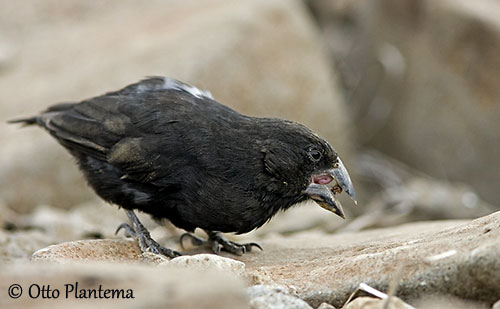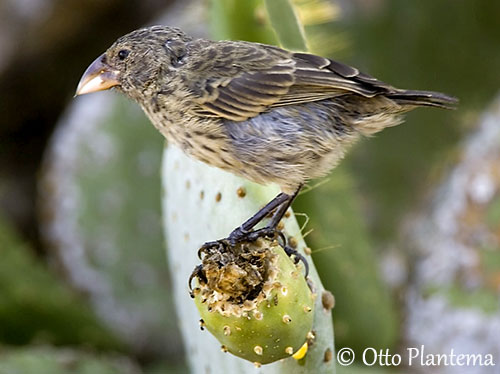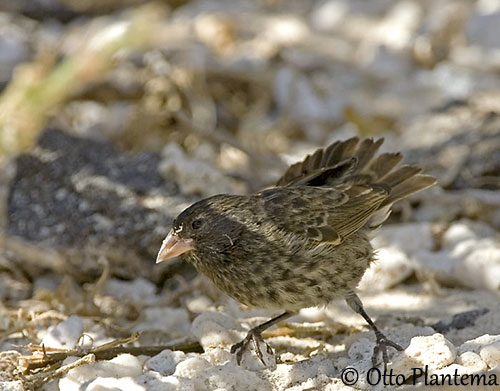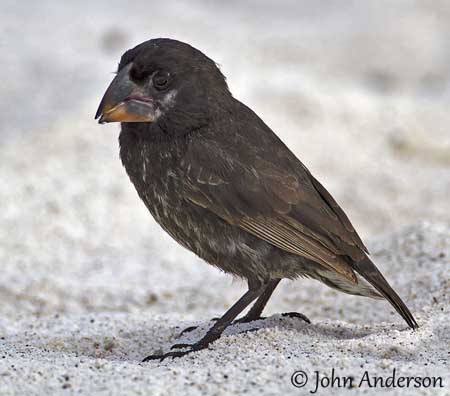
Fr: Géospize à bec conique
All: Opuntiengrundfink
Esp: Pinzón de Darwin de los Cactus, Pinzón cactero grande
Ital: Fringuello terricolo grosso dei cactus
Nd: Grote Cactusgrondvink
Sd: Större kaktusfink
Photographers:
John Anderson
John Anderson Photo Galleries
Otto Plantema
Trips around the world
Text by Nicole Bouglouan
Sources:
HANDBOOK OF THE BIRDS OF THE WORLD Vol 16 by Josep del Hoyo- Andrew Elliot-David Christie – Lynx Edicions – ISBN: 9788496553781
BirdLife International (BirdLife International)
Wikipedia, the free encyclopaedia
Large Cactus-Finch
Geospiza conirostris
Passeriforme Order – Thraupidae Family
Darwin’s Finches - Generalities
INTRODUCTION:
The Large Cactus-Finch is one of the « Darwin’s Finches », endemic to the Galapagos Islands. This dark bird is mainly terrestrial, and lives in dry shrubland. As its name suggests, this species gets its food from cactus.
DESCRIPTION OF THE BIRD:
Biometrics:
Length: 13-15 cm
Weight: 28 g
The Large Cactus-Finch is the largest of the Darwin’s Finches.
The adult of nominate race has black plumage overall, with brown wash on wings and tail. Undertail-coverts are white with black feather centres. The tail is relatively short.
The long, robust bill is black in breeding season, but it becomes brown with orange tinge at base and yellow tinge at tip during the transition. And finally, it is orange-yellow in non-breeding period.
The eyes are very dark. Legs and feet are blackish.

The female has dark brownish-grey streaked plumage. We can see paler feather edges on head, back and large part of breast. This streaking is usually narrow and indistinct. She has pale buffy-grey supercilium and lower eye-crescent, usually restricted to a pale spot above and behind the eye on darker birds.
The upperwing is brown with paler buffy-brown wingbars and tertial edges.
The underparts are whitish with dark brown streaking, denser on throat and breast. Belly and vent are paler. Undertail-coverts show broad whitish fringes.
The bill is dusky with some dull orange tinge on the lower mandible, or can be entirely orange according to the season.
The immature male is between the black adult male and the streaked female. It usually has black head and breast, with slightly streaked belly and back. Wings are darker than on female, more blackish, whereas wing-coverts and tertials are edged buff.
SUBSPECIES AND RANGE:
There are three subspecies:
G.c. darwini is found on Darwin and Wolf Islands, in extreme NW Galapagos. This race has slightly deeper and heavier bill than nominate, and there is often an olive wash on male’s rump.
G.c. propinqua occurs on Genovesa, in N Galapagos Islands. It is smaller and has more laterally compressed bill than nominate. The female is paler with paler streaking. (Full species)
G.c. conirostris (here described) is found on Española, in SE Galapagos Islands.
HABITAT:
The Large Cactus-Finch frequents the arid lowlands with dry scrub, and the areas with cacti of genus Opuntia helleri. This bird is often seen on the ground.
CALLS AND SONGS: SOUNDS BY XENO-CANTO
The Large Cactus-Finch’s calls include high-pitched “tzeeeeee”.
The song is a double nasal note “ch’whuuu ch’whuuu” or “tcheu tcheuuu”. This species has relatively high trill rate.
BEHAVIOUR IN THE WILD:
The Large Cactus-Finch gets most of its food from the prickly-pear cactus Opuntia helleri, from which it takes pulp, flowers, fruits and insects feeding on cactus flowers.
During the nesting period, the young birds are fed with parts of Opuntia helleri, but also with mixed diet of arthropods, fruits and seeds. The bird occurs only at sites where it can find large hard seeds and fruits.
During the non-breeding season, it feeds on seeds correlating with its bill size.

As other Darwin’s Finches, the Large Cactus-Finch’s reproduction is closely associated with rainfalls, and usually starts within a week of first rains.
But they may sometimes breed at many times in the year, due to the great variations of the rainfalls on Galapagos Islands.
They are monogamous. The female chooses her mate through song, plumage type and physical features which play a critical role during male/female interactions. The male is territorial and usually stays close to its mate during the egg-laying period.
As resident species, the pair maintains a small territory where the nest will be built.
During the breeding season, competition for food between different species is often intense. In this case, the different bill sizes allow the birds to feed different seeds when they co-inhabit the same island.
The Large Cactus-Finch is resident in its range. Outside the breeding season, it can forage off its territory. As resident species, it only performs short-distance flights. Its rounded wings are suitable for hops and manoeuvres in dense vegetation.

REPRODUCTION OF THIS SPECIES:
On Genovesa, the breeding season occurs between January and May, during the rainfalls.
The male builds the nest with dry grasses and other vegetation. This is a sphere with entrance towards the top and at side. It is placed in cacti or bushes.
But the male often builds display’s nests, before both mates build the actual nest together.
The female lays 3-4 whitish eggs with darker spots. She incubates during 12 days. The chicks fledge about 13-15 days after hatching. They are fed by both parents.
This species can produce up to 4 clutches per season.
Nestling and young birds are preyed upon by the Short-eared Owl (Asio flammeus). The adults can be taken by the Galapagos Hawk (Buteo galapagoensis).
The Large Cactus-Finch moults after the breeding season.
PROTECTION / THREATS / STATUS:
The Large Cactus-Finch is common within its small range, and its populations appear to be stable, with no evidence for any declines or threats.
This species is currently evaluated as Least Concern by BirdLife International.
